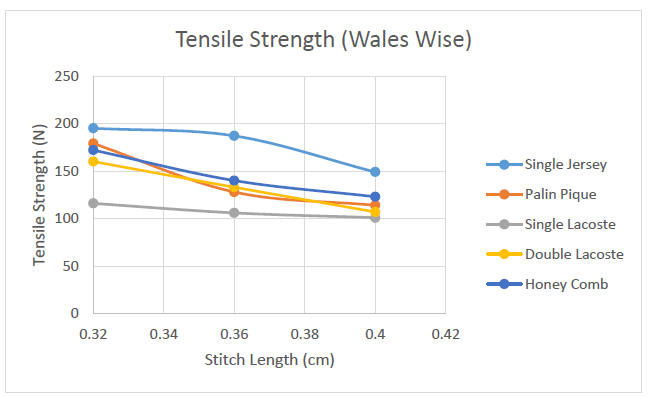Comparative Analysis of Structural Effect of Single Jersey and its Derivative Fabrics on Mechanical and Comfort Properties of Knitted Fabric
Abstract
 Abstract Views: 0
Abstract Views: 0
The physical, mechanical, and comfort properties of knitted fabrics depend on the type, shape, and number of loops per unit area. Physical properties, namely areal density depend on the ratio of knit, tuck, and miss stitches. The higher the ratio of touch stitches, the higher would be the areal density of the knitted fabric. Double Lacoste had a higher ratio of touch stitches and single jerseys had a zero ratio of tuck stitches. Noticeably, the double Lacoste had the highest areal density, whereas the single jersey had the lowest areal density among all knitted fabrics. Therefore, areal density was inversely proportional to the loop length. Mechanical properties such as tensile strength and bursting strength also depend upon the type and length of the loop. The knit loop had the highest tensile and bursting strength, which decreased as the ratio of touch stitches increased. Air permeability increased with the increasing ratio of tuck stitches and reduced when the fabric contains 100% of the knit loops.
Downloads
References
S. C. Ray, Fundamentals and Advances in Knitting Technology. Woodhead Publishing India Pvt. Limited, 2011.
J. J. F. Knapton and D. L. Munden, “A Study of the mechanism of loop formation on weft-knitting machinery: Part II: The effect of input tension and cam setting on loop formation,” Text. Res. J., vol. 36, no. 12, pp. 1072–1080, Dec. 1966, doi: https://doi.org/10.1177/004051756603601208
M. Rashed, “Effect of tuck loop in bursting strength of single jersey knitted fabrics,” Int. J. Res. Eng. Technol., vol. 3, no. 5, pp. 712–719, 2014.
El-Shiekh and S. Backer, “The mechanics of snagging in plain-knitted structures”, Text. Res. J., vol. 43, no. 5, pp. 262–271, May 1973, doi: https://doi.org/10.1177/004051757304300504
M. W. Suh, “A study of the shrinkage of plain knitted cotton fabric, based on the structural changes of the loop geometry due to yarn swelling and deswelling,” Text. Res. J., vol. 37, no. 5, pp. 417–431, May 1967, doi: https://doi.org/10.1177/004051756703700513
H. M. Fletcher and S. H. Roberts, “The relationship of the geometry of plain knit cotton fabric to its dimensional change and elastic properties,” Text. Res. J., vol. 24, no. 8, pp. 729–737, Aug. 1954, doi: https://doi.org/10.1177/004051755402400806
M. Karimian, H. Hasani, and S. Ajeli, “Analyzing the effect of fiber, yarn and fabric variables on bagging behavior of single jersey weft knitted fabrics,” J. Eng. Fibers Fabr., vol. 8, no. 3, Sep. 2013, doi: https://doi.org/10.1177/155892501300800301
N. Oglakcioglu, P. Celik, T. B. Ute, A. Marmarali, and H. Kadoglu, “Thermal comfort properties of angora rabbit/cotton fiber blended knitted fabrics,” Text. Res. J., vol. 79, no. 10, pp. 888–894, June 2009, doi: https://doi.org/10.1177/0040517508099396
W. E. Shinn, “An engineering approach to jersey fabric construction,” Text. Res. J., vol. 25, no. 3, pp. 270–277, Mar. 1955, doi: https://doi.org/10.1177/004051755502500314
M. S. Choi and S. P. Ashdown, “Effect of changes in knit structure and density on the mechanical and hand properties of weft-knitted fabrics for outerwear,” Text. Res. J., vol. 70, no. 12, Dec. 2000, doi: https://doi.org/10.1177/004051750007001201
S. Tornaletti, D. Rozek, and G. P. Pfeifer, “The distribution of UV photoproducts along the human p53 gene and its relation to mutations in skin cancer,” Oncogene., vol. 8, no. Oct. 2015, pp. 2051–2057, Sep. 1993.
A. Bivainyte and D. Mikucioniene, “Investigation on the dynamic water absorption of double-layered weft knitted fabrics,” Fibres Text. East. Eur., vol. 19, no. 6, pp. 64–70, 2011.
C. D. Kane, U. J. Patil, and P. Sudhakar, “Studies on the influence of knit structure and stitch length on ring and compact yarn single jersey fabric properties,” Text. Res. J., vol. 77, no. 8, pp. 572–582, Aug. 2007, doi: https://doi.org/10.1177/0040517507078023
N. A. Ibrahim, T. F. Khalifa, M. B. El-Hossamy, and T. M. Tawfik, “Effect of knit structure and finishing treatments on functional and comfort properties of cotton knitted fabrics,” J. Ind. Text., vol. 40, no. 1, pp. 49–64, Apr. 2010, doi: https://doi.org/10.1177/1528083709357975
P. Chidambaram, R. Govindan, and K. C. Venkatraman, “Study of thermal comfort properties of cotton/regenerated bamboo knitted fabrics,” African J. Basic. Appl. Sci., vol. 4, no. 2, pp. 60–66, 2012, doi: https://doi.org/10.5829/idosi.ajbas.2012.4.2.1032
C. D. Kane, U. J. Patil, and P. Sudhakar, “Studies on the Influence of knit structure and stitch length on ring and compact yarn single jersey fabric properties,” Text. Res. J., vol. 77, no. 8, pp. 572–582, Aug. 2007, doi: https://doi.org/10.1177/0040517507078023
N. Özdil, A. Marmarali, and S. D. Kretzschmar, “Effect of yarn properties on thermal comfort of knitted fabrics,” Int. J. Therm. Sci., vol. 46, no. 12, pp. 1318–1322, Dec. 2007, doi: https://doi.org/10.1016/j.ijthermalsci.2006.12.002

Copyright (c) 2023 Shehbaz Ahmad, Tanveer Hussain, Yasir Nawab, Habib Awais, Muzzamal Hussain, Waqas Ashraf

This work is licensed under a Creative Commons Attribution 4.0 International License.

This work is licensed under a Creative Commons Attribution 4.0 International License. Authors retain copyright and grant the journal right of first publication with the work simultaneously licensed under a Creative Commons Attribution (CC-BY) 4.0 License that allows others to share the work with an acknowledgement of the work’s authorship and initial publication in this journal.





